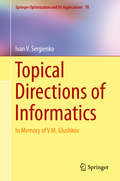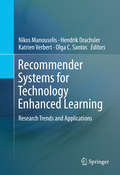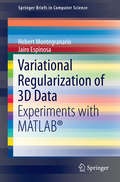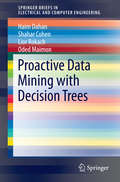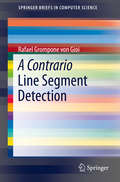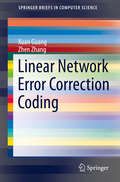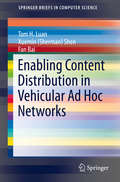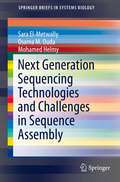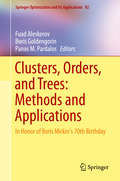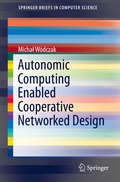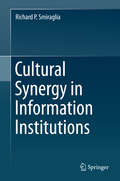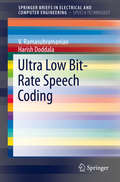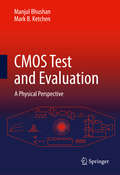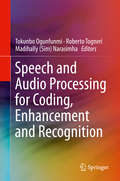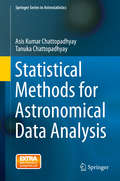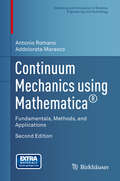- Table View
- List View
Topical Directions of Informatics
by Ivan V. SergienkoThis work is devoted to the late Ukrainian computer scientist V. M. Glushkov on the 90th anniversary of his birthday. Dr. Glushkov is known for his contribution to the world computer science and technology and this volume analyzes the ideas and paths of development of informatics formulated by him and demonstrate their important role in constructing computer technologies of basic research in the fields of applied mathematics, theories of computer programming and computing systems. A significant portion of the monograph is devoted to the elucidation of new results obtained in the field of mathematical modeling of complicated processes, creation of new methods for solving and investigating optimization problems in different statements and development of computer technologies for investigations in the field of economy, biology, medicine and information security in systems. The monograph will be of particular interest to informatics specialists and experts using methods of informatics and computer technologies to investigate complicated processes of different natures and developing new information technologies. It may also be useful for both graduate students and postgraduates specializing in Computer Science.
Recommender Systems for Technology Enhanced Learning
by Katrien Verbert Hendrik Drachsler Nikos Manouselis Olga C. SantosAs an area, Technology Enhanced Learning (TEL) aims to design, develop and test socio-technical innovations that will support and enhance learning practices of individuals and organizations. Information retrieval is a pivotal activity in TEL and the deployment of recommender systems has attracted increased interest during the past years. Recommendation methods, techniques and systems open an interesting new approach to facilitate and support learning and teaching. The goal is to develop, deploy and evaluate systems that provide learners and teachers with meaningful guidance in order to help identify suitable learning resources from a potentially overwhelming variety of choices. Contributions address the following topics: i) user and item data that can be used to support learning recommendation systems and scenarios, ii) innovative methods and techniques for recommendation purposes in educational settings and iii) examples of educational platforms and tools where recommendations are incorporated.
Variational Regularization of 3D Data
by Hebert Montegranario Jairo EspinosaVariational Regularization of 3D Data provides an introduction to variational methods for data modelling and its application in computer vision. In this book, the authors identify interpolation as an inverse problem that can be solved by Tikhonov regularization. The proposed solutions are generalizations of one-dimensional splines, applicable to n-dimensional data and the central idea is that these splines can be obtained by regularization theory using a trade-off between the fidelity of the data and smoothness properties. As a foundation, the authors present a comprehensive guide to the necessary fundamentals of functional analysis and variational calculus, as well as splines. The implementation and numerical experiments are illustrated using MATLAB®. The book also includes the necessary theoretical background for approximation methods and some details of the computer implementation of the algorithms. A working knowledge of multivariable calculus and basic vector and matrix methods should serve as an adequate prerequisite.
Proactive Data Mining with Decision Trees
by Lior Rokach Haim Dahan Shahar Cohen Oded MaimonThis book explores a proactive and domain-driven method to classification tasks. This novel proactive approach to data mining not only induces a model for predicting or explaining a phenomenon, but also utilizes specific problem/domain knowledge to suggest specific actions to achieve optimal changes in the value of the target attribute. In particular, the authors suggest a specific implementation of the domain-driven proactive approach for classification trees. The book centers on the core idea of moving observations from one branch of the tree to another. It introduces a novel splitting criterion for decision trees, termed maximal-utility, which maximizes the potential for enhancing profitability in the output tree. Two real-world case studies, one of a leading wireless operator and the other of a major security company, are also included and demonstrate how applying the proactive approach to classification tasks can solve business problems. Proactive Data Mining with Decision Trees is intended for researchers, practitioners and advanced-level students.
A Contrario Line Segment Detection (SpringerBriefs in Computer Science)
by Rafael Grompone von GioiThe reliable detection of low-level image structures is an old and still challenging problem in computer vision. This book leads a detailed tour through the LSD algorithm, a line segment detector designed to be fully automatic. Based on the a contrario framework, the algorithm works efficiently without the need of any parameter tuning. The design criteria are thoroughly explained and the algorithm's good and bad results are illustrated on real and synthetic images. The issues involved, as well as the strategies used, are common to many geometrical structure detection problems and some possible extensions are discussed.
Linear Network Error Correction Coding
by Xuan Guang Zhen ZhangThere are two main approaches in the theory of network error correction coding. In this SpringerBrief, the authors summarize some of the most important contributions following the classic approach, which represents messages by sequences similar to algebraic coding, and also briefly discuss the main results following the other approach, that uses the theory of rank metric codes for network error correction of representing messages by subspaces. This book starts by establishing the basic linear network error correction (LNEC) model and then characterizes two equivalent descriptions. Distances and weights are defined in order to characterize the discrepancy of these two vectors and to measure the seriousness of errors. Similar to classical error-correcting codes, the authors also apply the minimum distance decoding principle to LNEC codes at each sink node, but use distinct distances. For this decoding principle, it is shown that the minimum distance of a LNEC code at each sink node can fully characterize its error-detecting, error-correcting and erasure-error-correcting capabilities with respect to the sink node. In addition, some important and useful coding bounds in classical coding theory are generalized to linear network error correction coding, including the Hamming bound, the Gilbert-Varshamov bound and the Singleton bound. Several constructive algorithms of LNEC codes are presented, particularly for LNEC MDS codes, along with an analysis of their performance. Random linear network error correction coding is feasible for noncoherent networks with errors. Its performance is investigated by estimating upper bounds on some failure probabilities by analyzing the information transmission and error correction. Finally, the basic theory of subspace codes is introduced including the encoding and decoding principle as well as the channel model, the bounds on subspace codes, code construction and decoding algorithms.
Enabling Content Distribution in Vehicular Ad Hoc Networks
by Xuemin Sherman Shen Tom H. Luan Fan BaiThis SpringerBrief presents key enabling technologies and state-of-the-art research on delivering efficient content distribution services to fast moving vehicles. It describes recent research developments and proposals towards the efficient, resilient and scalable content distribution to vehicles through both infrastructure-based and infrastructure-less vehicular networks. The authors focus on the rich multimedia services provided by vehicular environment content distribution including vehicular communications and media playback, giving passengers many infotainment applications. Common problems of vehicular network research are addressed, including network design and optimization, standardization, and the adaptive playout from a user's perspective.
Biomedical Literature Mining (Methods in Molecular Biology #1159)
by Vinod D. Kumar Hannah Jane TipneyBiomedical Literature Mining, discusses the multiple facets of modern biomedical literature mining and its many applications in genomics and systems biology. The volume is divided into three sections focusing on information retrieval, integrated text-mining approaches and domain-specific mining methods. Written in the highly successful Methods in Molecular Biology series format, chapters include introductions to their respective topics, lists of the necessary materials and reagents, step-by-step, readily reproducible laboratory protocols and key tips on troubleshooting and avoiding known pitfalls. Authoritative and practical, Biomedical Literature Mining is designed as a useful bioinformatics resource in biomedical literature text mining for both those long experienced in or entirely new to, the field.
Next Generation Sequencing Technologies and Challenges in Sequence Assembly
by Sara El-Metwally Osama M. Ouda Mohamed HelmyThe introduction of Next Generation Sequencing (NGS) technologies resulted in a major transformation in the way scientists extract genetic information from biological systems, revealing limitless insight about the genome, transcriptome and epigenome of any species. However, with NGS, came its own challenges that require continuous development in the sequencing technologies and bioinformatics analysis of the resultant raw data and assembly of the full length genome and transcriptome. Such developments lead to outstanding improvements of the performance and coverage of sequencing and improved quality for the assembled sequences, nevertheless, challenges such as sequencing errors, expensive processing and memory usage for assembly and sequencer specific errors remains major challenges in the field. This book aims to provide brief overviews the NGS field with special focus on the challenges facing the NGS field, including information on different experimental platforms, assembly algorithms and software tools, assembly error correction approaches and the correlated challenges.
Clusters, Orders, and Trees: In Honor of Boris Mirkin's 70th Birthday (Springer Optimization and Its Applications #92)
by Panos M. Pardalos Boris Goldengorin Fuad AleskerovThe volume is dedicated to Boris Mirkin on the occasion of his 70th birthday. In addition to his startling PhD results in abstract automata theory, Mirkin's ground breaking contributions in various fields of decision making and data analysis have marked the fourth quarter of the 20th century and beyond Mirkin has done pioneering work in group choice, clustering, data mining and knowledge discovery aimed at finding and describing non-trivial or hidden structures--first of all, clusters, orderings and hierarchies--in multivariate and/or network data. This volume contains a collection of papers reflecting recent developments rooted in Mirkin's fundamental contribution to the state-of-the-art in group choice, ordering, clustering, data mining and knowledge discovery. Researchers, students and software engineers will benefit from new knowledge discovery techniques and application directions.
Autonomic Computing Enabled Cooperative Networked Design (SpringerBriefs in Computer Science)
by Michał WódczakThis book introduces the concept of autonomic computing driven cooperative networked system design from an architectural perspective. As such it leverages and capitalises on the relevant advancements in both the realms of autonomic computing and networking by welding them closely together. In particular, a multi-faceted Autonomic Cooperative System Architectural Model is defined which incorporates the notion of Autonomic Cooperative Behaviour being orchestrated by the Autonomic Cooperative Networking Protocol of a cross-layer nature. The overall proposed solution not only advocates for the inclusion of certain Decision Making Entities, but it also provides all the necessary implementation guidelines along with the pertinent standardisation orientated insight.
Handbook of Mathematical Methods in Imaging
by Otmar ScherzerThe Handbook of Mathematical Methods in Imaging provides a comprehensive treatment of the mathematical techniques used in imaging science. The material is grouped into two central themes, namely, Inverse Problems (Algorithmic Reconstruction) and Signal and Image Processing. Each section within the themes covers applications (modeling), mathematics, numerical methods (using a case example) and open questions. Written by experts in the area, the presentation is mathematically rigorous. The entries are cross-referenced for easy navigation through connected topics. Available in both print and electronic forms, the handbook is enhanced by more than 150 illustrations and an extended bibliography. It will benefit students, scientists and researchers in applied mathematics. Engineers and computer scientists working in imaging will also find this handbook useful.
Clinical Bioinformatics (Methods in Molecular Biology #1168)
by Ronald TrentIn Clinical Bioinformatics, Second Edition, leading experts in the field provide a series of articles focusing on software applications used to translate information into outcomes of clinical relevance. Recent developments in omics, such as increasingly sophisticated analytic platforms allowing changes in diagnostic strategies from the traditional focus on single or small number of analytes to what might be possible when large numbers or all analytes are measured, are now impacting patient care. Covering such topics as gene discovery, gene function (microarrays), DNA sequencing, online approaches and resources, and informatics in clinical practice, this volume concisely yet thoroughly explores this cutting-edge subject Written in the successful Methods in Molecular Biology series format, chapters include introductions to their respective topics, lists of the necessary materials and reagents, step-by-step, readily reproducible protocols, and notes on troubleshooting and avoiding known pitfalls. Authoritative and easily accessible, Clinical Bioinformatics, Second Edition serves as an ideal guide for scientists and health professionals working in genetics and genomics.
Cyberterrorism: Understanding, Assessment, and Response
by Thomas M. Chen Lee Jarvis Stuart MacdonaldThis is the first book to present a multidisciplinary approach to cyberterrorism It traces the threat posed by cyberterrorism today, with chapters discussing possible technological vulnerabilities, potential motivations to engage in cyberterrorism, and the challenges of distinguishing this from other cyber threats. The book also addresses the range of potential responses to this threat by exploring policy and legislative frameworks as well as a diversity of techniques for deterring or countering terrorism in cyber environments. The case studies throughout the book are global in scope and include the United States, United Kingdom, Australia, New Zealand and Canada. With contributions from distinguished experts with backgrounds including international relations, law, engineering, computer science, public policy and politics, Cyberterrorism: Understanding, Assessment and Response offers a cutting edge analysis of contemporary debate on, and issues surrounding, cyberterrorism. This global scope and diversity of perspectives ensure it is of great interest to academics, students, practitioners, policymakers and other stakeholders with an interest in cyber security.
Virtual Reality for Physical and Motor Rehabilitation
by Patrice L. Tamar Weiss Emily A. Keshner Mindy F. LevinWhile virtual reality (VR) has influenced fields as varied as gaming, archaeology and the visual arts, some of its most promising applications come from the health sector. Particularly encouraging are the many uses of VR in supporting the recovery of motor skills following accident or illness. Virtual Reality for Physical and Motor Rehabilitation reviews two decades of progress and anticipates advances to come. It offers current research on the capacity of VR to evaluate, address, and reduce motor skill limitations and the use of VR to support motor and sensorimotor function, from the most basic to the most sophisticated skill levels. Expert scientists and clinicians explain how the brain organizes motor behavior, relate therapeutic objectives to client goals and differentiate among VR platforms in engaging the production of movement and balance. On the practical side, contributors demonstrate that VR complements existing therapies across various conditions such as neurodegenerative diseases, traumatic brain injury and stroke. Included among the topics: Neuroplasticity and virtual reality. Vision and perception in virtual reality. Sensorimotor recalibration in virtual environments. Rehabilitative applications using VR for residual impairments following stroke. VR reveals mechanisms of balance and locomotor impairments. Applications of VR technologies for childhood disabilities. A resource of great immediate and future utility, Virtual Reality for Physical and Motor Rehabilitation distills a dynamic field to aid the work of neuropsychologists, rehabilitation specialists (including physical, speech, vocational and occupational therapists), and neurologists.
Cyber-Development, Cyber-Democracy and Cyber-Defense: Challenges, Opportunities and Implications for Theory, Policy and Practice
by Elias G. Carayannis David F. J. Campbell Marios Panagiotis EfthymiopoulosIn this volume, contributors from academia, industry, and policy explore the inter-connections among economic development, socio-political democracy and defense and security in the context of a profound transformation, spurred by globalization and supported by the rapid development of information and communication technologies (ICT). This powerful combination of forces is changing the way we live and redefining the way companies conduct business and national governments pursue strategies of innovation, economic growth and diplomacy. Integrating theoretical frameworks, empirical research and case studies, the editors and contributors have organized the chapters into three major sections, focusing on cyber-development, cyber-democracy and cyber-defense. The authors define cyber-development as a set of tools, methodologies and practices that leverage ICT to catalyze and accelerate social, political and economic development, with an emphasis on making the transition to knowledge-based economies. One underlying understanding here is that knowledge, knowledge creation, knowledge production and knowledge application (innovation) behave as crucial drivers for enhancing democracy, society, and the economy. By promoting dissemination and sharing of knowledge, cyber-democracy allows a knowledge conversion of the local into the global (gloCal) and vice versa, resulting in a gloCal platform for communication and knowledge interaction and knowledge enhancement Meanwhile, technology-enabled interconnectivity increases the need to adopt new methods and actions for protection against existing threats and possible challenges to emerge in the future The final section contemplates themes of cyber-defense and security, as well as emerging theories and values, legal aspects and trans-continental links (NATO, international organizations and bilateral relations between states) Collectively, the authors present a unique collection of insights and perspectives on the challenges and opportunities inspired by connectivity.
Immunoinformatics
by Rajat K. De Namrata TomarAt the intersection of experimental and computational sciences, the second edition of Immunoinformatics provides biological insights as well as a simpler way to implement approaches and algorithms in the immunoinformatics research domain. After an introductory section, this extensive volume moves on to cover topics such as databases, tools for prediction, systems biology approaches, as well as a variety of immunoinformatics applications. As part of the highly successful Methods in Molecular Biology series, chapters include the type of detailed information and implementation advice to ensure successful results. Comprehensive and practical, Immunoinformatics, Second Edition aims at students and researchers from diverse backgrounds and levels interested in working with immunological problems.
Cultural Synergy in Information Institutions
by Richard P. SmiragliaCultural forces govern a synergistic relationship among information institutions that shapes their roles collectively and individually. Cultural synergy is the combination of perception- and behavior-shaping knowledge within, between, and among groups. Our hyperlinked era makes information-sharing among institutions critically important for scholarship as well as for the advancement of humankind. Information institutions are those that have, or share in, the mission to preserve, conserve, and disseminate information objects and their informative content. A central idea is the notion of social epistemology that information institutions arise culturally from social forces of the cultures they inhabit, and that their purpose is to disseminate that culture. All information institutions are alike in critical ways. Intersecting lines of cultural mission are trajectories for synergy for allowing us to perceive the universe of information institutions as interconnected and evolving and moving forward in distinct ways for the improvement of the condition of humankind through the building up of its knowledge base and of its information-sharing processes. This book is an exploration of the cultural synergy that can be realized by seeing commonalities among information institutions (sometimes also called cultural heritage institutions): museums, libraries, and archives. The hyperlinked era of the Semantic Web makes information sharing among institutions critically important for scholarship as well as the advancement of mankind. The book addresses the origins of cultural information institutions, the history of the professions that run them, and the social imperative of information organization as a catalyst for semantic synergy.
The Work of Art in a Digital Age: Art, Technology and Globalisation
by Melissa LangdonThis book explores digital artists' articulations of globalization. Digital artworks from around the world are examined in terms of how they both express and simulate globalization's impacts through immersive, participatory and interactive technologies. The author highlights some of the problems with macro and categorical approaches to the study of globalization and presents new ways of seeing the phenomenon as a series of processes and flows that are individually experienced and expressed. Instead of providing a macro analysis of large-scale political and economic processes, the book offers imaginative new ways of knowing and understanding globalization as a series of micro affects. Digital art is explored in terms of how it re-centers articulations of globalization around individual experiences and offers new ways of accessing a complex topic often expressed in general and intangible terms. The Work of Art in a Digital Age: Art, Technology and Globalization is analytic and accessible, with material that is of interest to a range of researchers from different disciplines. Students studying digital art, film, globalization, cultural studies or digital media trends will also find the content fascinating.
Ultra Low Bit-Rate Speech Coding
by V. Ramasubramanian Harish Doddala"Ultra Low Bit-Rate Speech Coding" focuses on the specialized topic of speech coding at very low bit-rates of 1 Kbits/sec and less, particularly at the lower ends of this range, down to 100 bps. The authors set forth the fundamental results and trends that form the basis for such ultra low bit-rates to be viable and provide a comprehensive overview of various techniques and systems in literature to date, with particular attention to their work in the paradigm of unit-selection based segment quantization. The book is for research students, academic faculty and researchers, and industry practitioners in the areas of speech processing and speech coding.
CMOS Test and Evaluation: A Physical Perspective
by Mark B. Ketchen Manjul BhushanCMOS Test and Evaluation: A Physical Perspective is a single source for an integrated view of test and data analysis methodology for CMOS products, covering circuit sensitivities to MOSFET characteristics, impact of silicon technology process variability, applications of embedded test structures and sensors, product yield, and reliability over the lifetime of the product. This book also covers statistical data analysis and visualization techniques, test equipment and CMOS product specifications, and examines product behavior over its full voltage, temperature and frequency range.
Cancer Bioinformatics
by Ying Xu Juan Cui David PuettThis book provides a framework for computational researchers studying the basics of cancer through comparative analyses of omic data. It discusses how key cancer pathways can be analyzed and discovered to derive new insights into the disease and identifies diagnostic and prognostic markers for cancer. Chapters explain the basic cancer biology and how cancer develops, including the many potential survival routes. The examination of gene-expression patterns uncovers commonalities across multiple cancers and specific characteristics of individual cancer types. The authors also treat cancer as an evolving complex system, explore future case studies, and summarize the essential online data sources. Cancer Bioinformatics is designed for practitioners and researchers working in cancer research and bioinformatics. It is also suitable as a secondary textbook for advanced-level students studying computer science, biostatistics or biomedicine.
Speech and Audio Processing for Coding, Enhancement and Recognition
by Tokunbo Ogunfunmi Roberto Togneri Madihally Sim NarasimhaThis book describes the basic principles underlying the generation, coding, transmission and enhancement of speech and audio signals, including advanced statistical and machine learning techniques for speech and speaker recognition with an overview of the key innovations in these areas. Key research undertaken in speech coding, speech enhancement, speech recognition, emotion recognition and speaker diarization are also presented, along with recent advances and new paradigms in these areas.
Statistical Methods for Astronomical Data Analysis
by Asis Kumar Chattopadhyay Tanuka ChattopadhyayThis book introduces "Astrostatistics" as a subject in its own right with rewarding examples, including work by the authors with galaxy and Gamma Ray Burst data to engage the reader. This includes a comprehensive blending of Astrophysics and Statistics. The first chapter's coverage of preliminary concepts and terminologies for astronomical phenomenon will appeal to both Statistics and Astrophysics readers as helpful context. Statistics concepts covered in the book provide a methodological framework. A unique feature is the inclusion of different possible sources of astronomical data, as well as software packages for converting the raw data into appropriate forms for data analysis. Readers can then use the appropriate statistical packages for their particular data analysis needs. The ideas of statistical inference discussed in the book help readers determine how to apply statistical tests. The authors cover different applications of statistical techniques already developed or specifically introduced for astronomical problems, including regression techniques, along with their usefulness for data set problems related to size and dimension. Analysis of missing data is an important part of the book because of its significance for work with astronomical data. Both existing and new techniques related to dimension reduction and clustering are illustrated through examples. There is detailed coverage of applications useful for classification, discrimination, data mining and time series analysis. Later chapters explain simulation techniques useful for the development of physical models where it is difficult or impossible to collect data. Finally, coverage of the many R programs for techniques discussed makes this book a fantastic practical reference. Readers may apply what they learn directly to their data sets in addition to the data sets included by the authors.
Continuum Mechanics using Mathematica®: Fundamentals, Methods, and Applications (Modeling and Simulation in Science, Engineering and Technology)
by Antonio Romano Addolorata MarascoThis textbook's methodological approach familiarizes readers with the mathematical tools required to correctly define and solve problems in continuum mechanics. Covering essential principles and fundamental applications, this second edition of Continuum Mechanics using Mathematica® provides a solid basis for a deeper study of more challenging and specialized problems related to nonlinear elasticity, polar continua, mixtures, piezoelectricity, ferroelectricity, magneto-fluid mechanics and state changes (see A. Romano, A. Marasco, Continuum Mechanics: Advanced Topics and Research Trends, Springer (Birkhäuser), 2010, ISBN 978-0-8176-4869-5). Key topics and features: * Concise presentation strikes a balance between fundamentals and applications * Requisite mathematical background carefully collected in two introductory chapters and one appendix * Recent developments highlighted through coverage of more significant applications to areas such as wave propagation, fluid mechanics, porous media, linear elasticity. This second edition expands the key topics and features to include: * Two new applications of fluid dynamics: meteorology and navigation * New exercises at the end of the existing chapters * The packages are rewritten for Mathematica 9 Continuum Mechanics using Mathematica®: Fundamentals, Applications and Scientific Computing is aimed at advanced undergraduates, graduate students and researchers in applied mathematics, mathematical physics and engineering. It may serve as a course textbook or self-study reference for anyone seeking a solid foundation in continuum mechanics.
